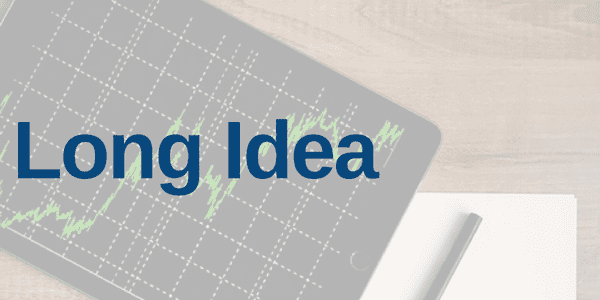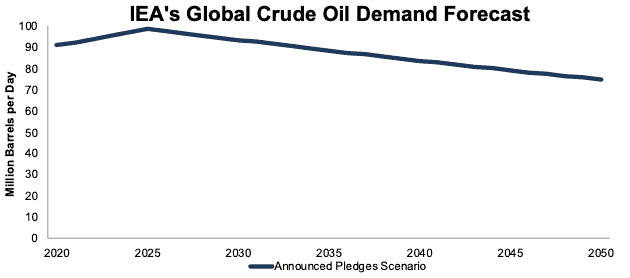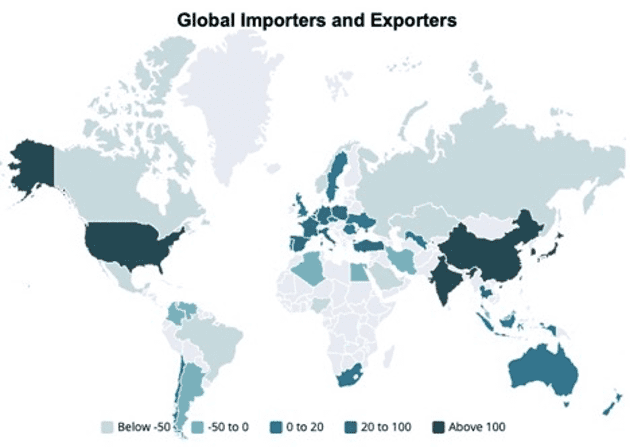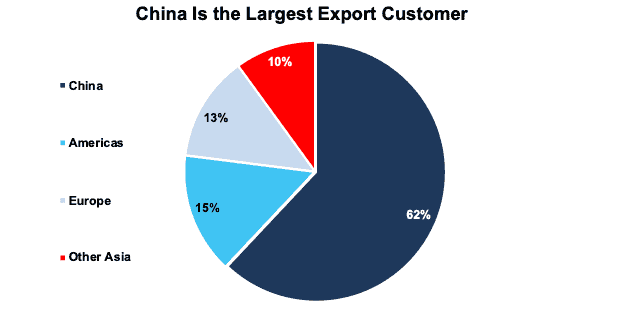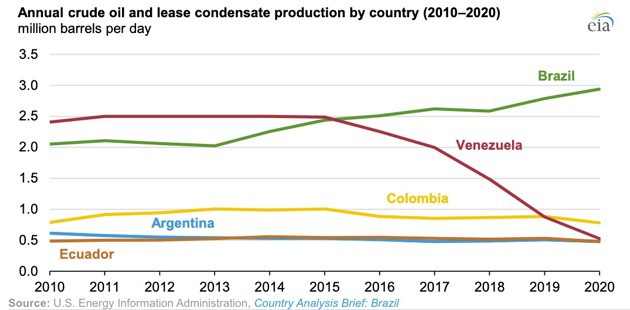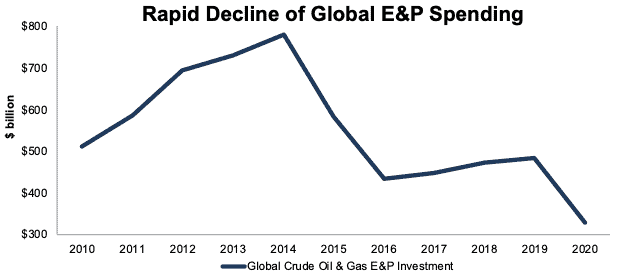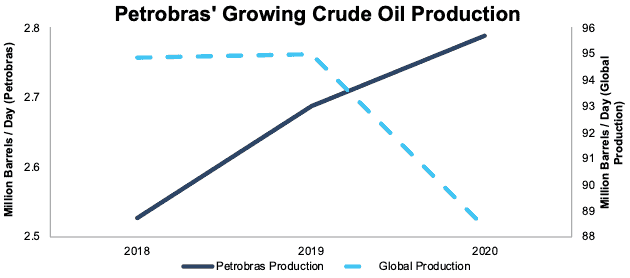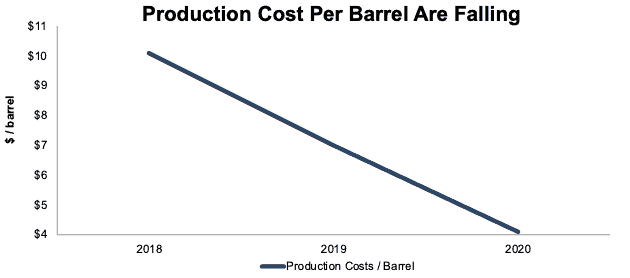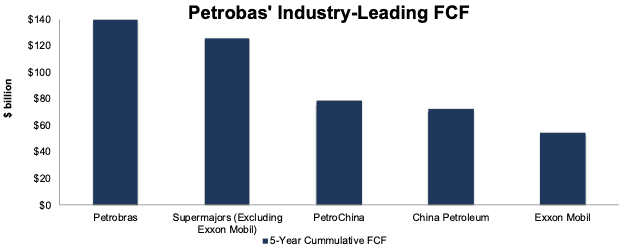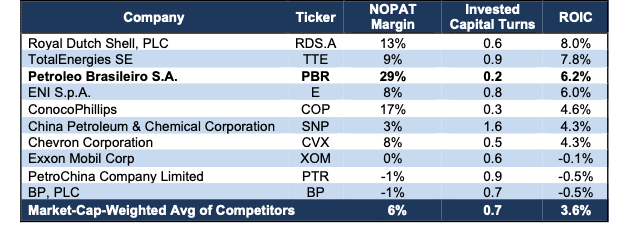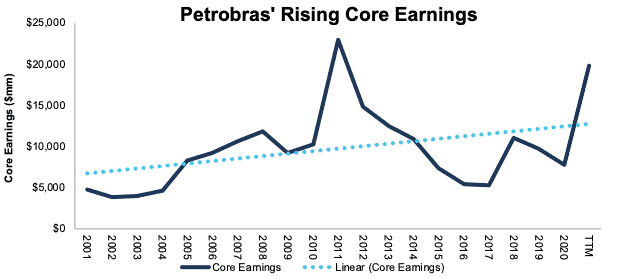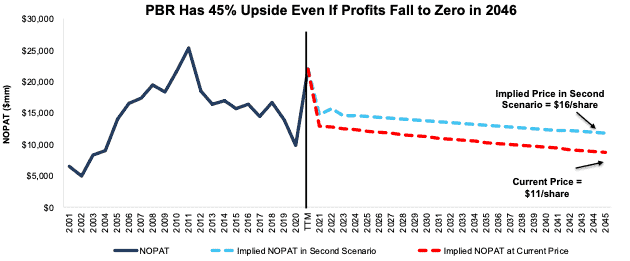We published an update on this Long Idea on August 23, 2023. A copy of the associated report is here.
Editor’s Note on 1/7/2022
We updated Petrobras’ (PBR: $11/share) market cap and the future cash flow expectations implied by its valuation after we corrected the TTM shares outstanding value used in our model.
Our thesis remains unchanged. Petrobras’ valuation implies NOPAT will fall to zero after 2045, despite the IEA’s expectations of strong oil demand persisting well beyond 2045.
Despite the world’s persistent reliance on fossil fuels, much of the energy industry is foregoing the capital investments needed to meet future energy demand. This state-controlled operator is unabashedly prepared to grow its crude oil production while others divest and ties executive compensation to ROIC. Petroleo Brasileiro (Petrobras) (PBR: $11/share) is this week’s Long Idea.
PBR presents quality risk/reward given the:
- long-term global and domestic demand for crude oil
- flexibility of Petrobras’ large tanker fleet
- success of its deep sea and ultra-deep sea pre-salt production
- industry-leading free cash flow (FCF) generation to fund future crude oil and gas exploration and production
- cheap valuation assumes fossil fuel demand goes to zero and more than offsets geopolitical risks
Global Demand for Fossil Fuels Will Be Strong for Decades
Fossil fuels provide enormous social and economic benefits that are not easily substitutable. Figure 1 shows the International Energy Agency’s (IEA) global demand forecast of crude oil products if all countries included in the Paris Agreement meet their announced carbon-reducing climate pledges. We doubt these reduction targets will be met, as discussed in our recent report on Royal Dutch Shell (RDS.A), but even if they are, demand for crude oil will be substantial even after decades of aggressive carbon-reducing efforts.
Figure 1: IEA Crude Oil Demand Forecast: Announced Pledges Scenario Through 2050
Sources: New Constructs, LLC and IEA.
Domestic Demand in Brazil Is Also Growing
Brazil’s consumption of fossil fuels will likely grow for decades. The Energy Information Administration’s (EIA) reference case shows Brazil’s crude oil consumption rising 34% over the next 30 years from 5.8 quadrillion British thermal units in 2020 to 7.8 quadrillion in 2050.
As Brazil’s crude oil and gas monopoly, Petrobras is well-positioned to benefit from growth in Brazil’s demand for crude. In 2020, Petrobras exported just 27% of its crude oil.
Oil Tankers Provide Distribution Advantage
Unlike many other producers, such as Russia, that are tied to end customers through pipelines and complex geopolitical relationships, Petrobras operates a fleet of 131 ocean-going oil tankers to deliver its products from its offshore oil fields to domestic and global markets. Petrobras’ use of tankers gives it both operational and marketing flexibility.
Operationally, oil tankers better support the company’s ultra-deep water production efforts, which can encounter harsh water conditions not suitable for pipelines. In addition, unlike pipelines that mix all qualities of oil within the system, oil tankers keep higher-value oil separate from lower value types.
On the marketing side, oil tankers maximize the number of markets Petrobras can serve. Petrobras’ oil tankers offer a cost-effective way to supply a variety of customers the world over. Figure 2 shows global oil trade on a net basis, with imports denoted as a positive number. The largest importers, China and the United States, sit on opposite sides of the world from one another geographically and strategically.
Figure 2: Net Crude Oil Trade by Country (Values in Metric Tons): 2020
Source: Enerdata.
Political Neutrality Broadens Its Addressable Market…And Reduces Risk of Customer Concentration
Brazil’s pre-salt crude oil makes it an extremely attractive option for Chinese refiners who also process Chinese grade oils with similar characteristics. Per Figure 3, China accounted for 62% of Brazil’s export volumes in 2020.
However, the large concentration of exports to China does not mean Petrobras is beholden to China. Pre-salt crude oil appeals to numerous potential buyers across the globe, which means Petrobras has flexibility to redirect its production to other end users. No buyer can hold Petrobras hostage.
Brazil’s history of neutrality makes it an ideal trading partner for customers looking to lower geopolitical risk within their operations, too. In addition to China, Petrobras supplies Latin America, Europe, the U.S., and India. Furthermore, Petrobras can sell its low-sulfur bunker oil worldwide because it complies with the International Maritime Organization’s (IMO) regulations.
Vertical Integration Boosts Margins and Operational Flexibility
The company’s vertical integration into refining enables it to arbitrage internationally across the crack spread by switching from selling crude oil to refined fuels. In 1Q21, Petrobras reduced crude oil exports to China in favor of selling higher-margin diesel to its domestic market.
Figure 3: Export Volumes Sold by Region: 2020
Source: New Constructs, LLC and company filings.
Venezuela’s Loss Is Petrobras’ Gain in the Region
Figure 4 shows that while Venezuela once dominated production in South America, Brazil is now the clear leader amongst its regional competitors. Venezuela’s production collapse has aided Brazil’s ~50% gain in crude oil production since 2013. With the removal of this key competitor, Petrobras can expand marginal production with limited regional competition.
It seems unlikely that Venezuela will ever be able to significantly recover from its lost production if the same government that oversaw its downfall remains in power. Meanwhile, the U.S. embargo will continue to hinder its production recovery.
Even if Venezuela can get more oil production online, Petrobras’ growing production of lower-sulfur pre-salt crude oil is much more preferred globally to Venezuela’s heavy, high-sulfur crude oil.
Figure 4: Crude Oil Production by Regional Competitors Since 2010
Sources: EIA.
Filling the Gap - Investing Where Others Won’t
Many of the world’s supermajors face immense political pressure to increase investments in unproven alternative energy solutions and reduce fossil fuel production. Petrobras is less incumbered by these political pressures. The company is seizing the opportunity to meet long-term crude oil demand as it expands its fossil fuel operations in the void left behind by departing firms,
Per Figure 5, global investment in fossil fuel exploration and production (E&P) fell from $779 billion in 2014 to $328 billion in 2020. Petrobras recently announced plans to invest $57 billion (17% of global 2020 E&P investment) in E&P activities from 2022 to 2026.
Figure 5: Global Investment in Crude Oil & Gas Since 2010
Sources: New Constructs, LLC and IEA.
Production Growth Likely to Continue
Though Petrobras suffered from weakened domestic demand in 2020, the company leveraged its flexible operating structure to bolster its exports. Indeed, Brazil was the only country in its region to increase production in 2020. Figure 6 shows Petrobras’ crude oil production volume rose from 2.5 million barrels per day (mmb/d) in 2018 to 2.8 mmb/d in 2020 while global crude oil production fell from 94.9 mmb/d to 88.4 mmb/d.
Looking ahead, Petrobras aims to produce 20 billion barrels of crude oil and gas products in the next ten years compared to the 23 billion barrels it has produced in the previous 68 years.
Figure 6: Petrobras’ and Global Crude Oil Production Volumes from 2018 to 2020
Source: New Constructs, LLC and company filings.
Declining Unit Costs Will Keep the Cash Flowing
Petrobras’ increased production coincides with a decline in its per barrel cost of production. The company’s average production cost per barrel of oil has fallen from $10.11 per barrel in 2019 to $4.11 per barrel in 2020, per Figure 7. After accounting for taxes and depreciation, depletion, and amortization costs, the company estimates its forward breakeven level of its pre-salt operations to be ~$20/barrel. For reference, the average daily closing price of Brent crude oil over the past five years is $60.31/barrel.
Figure 7: Petrobras’ Average Production Cost per Barrel from 2018 to 2020
Source: New Constructs, LLC and company filings.
Increased Production and Falling Unit Costs Generate Huge Free Cash Flow
As Petrobras has ramped up production and improved its per barrel costs, the firm led its peers in free cash flow generation over the past five years. From 2016 to 2020, Petrobras generated $140.1 billion in free cash flow (FCF), which is more than the combined five-year cumulative FCF of all supermajors[1] except Exxon Mobil (XOM), nearly equal to the combined five-year FCF of PetroChina (PTR) and China Petroleum (SNP), and 2.5x more than Exxon Mobil on its own. See Figure 8.
With reserves that can sustain another 9.6 years of 2020-production levels, large capital investments in E&P projects, and declining per barrel production costs, the company is positioned to continue generating industry-leading cash flows.
Figure 8: Petrobras’ 5-Year FCF Vs. Competitors: TTM
Sources: New Constructs, LLC and company filings
Petrobras May Be Greener Than You Realize
Petrobras’ commitment to fossil fuels doesn’t mean that it is unwilling to lower its carbon emissions. While increasing its fossil fuel production, Petrobras has reduced its carbon emissions per barrel by nearly half over the past eleven years. The firm seems ready to drive its emissions even lower and recently stated its aim to achieve net zero carbon emissions by 2050.
Deepwater drilling is lower carbon producing than onshore production. With 94% of its 2020 production originating from deepwater and ultra-deepwater reservoirs, Petrobras’ portfolio is much more carbon friendly than onshore producers.
The firm also invests in biofuel projects such as renewable diesel and biojet fuel produced from vegetable oils. Petrobras increased its biodiesel production by 23% from 2018 to 2020 and supplied nearly 5% of the country’s biodiesel demand in 2020.
More Profitable Than Peers
Per Figure 9, Petrobras has the third highest return on invested capital (ROIC) amongst its peers over the TTM. Petrobras’ net operating profit after-tax (NOPAT) margin rose from 16% in 2017 to 29% over the TTM, while ROIC rose from 4% to 6% over the same time. Peers include PetroChina (PTR), China Petroleum (SNP), Exxon Mobil (XOM), Chevron (CVX), Royal Dutch Shell (RDS.A), Total Energies (TTE), BP (BP), ConocoPhillips (COP), and Eni (E).
Figure 9: Petrobras’ Profitability Vs. Peers: TTM
Sources: New Constructs, LLC and company filings
Core Earnings Are Rising
Petrobras operates an impressively resilient business in a very cyclical sector. The firm has generated positive Core Earnings in each of the past 20 years. More recently, Petrobras grew Core Earnings from $5.3 billion in 2017 to $19.9 billion over the TTM. Per Figure 10, Petrobras’ Core Earnings have been trending higher over the past two decades despite year-to-year fluctuation.
Figure 10: Petrobras’ Core Earnings Since 2001
Sources: New Constructs, LLC and company filings.
Potential Risks Are Already Priced Into the Stock
Despite the positives, there are a few potential headwinds facing Petrobras. We detail each below, but given the stock’s cheap valuation, each concern is more than priced in.
Political Risk Can’t Be Ignored. As a state-controlled entity, Petrobras encounters more risk of governmental intervention than other energy companies. After raising fuel prices by 30% in a two month period, President Bolsonaro ousted the company’s CEO in February 2021, a move that surprised investors and caused shares to fall 33% in a three-week period.
The current inflationary environment may tempt government officials to reintroduce domestic price controls on fuel, which could cause a major blow to Petrobras’ profits.
The Brazilian government also threatens Petrobras’ bottom line with its tax policy. The government is exploring the implementation of a variable export tax tied to the price of Brent crude oil, which could prove to be a headwind on this segment vital to the marginal growth of the company’s production.
However, even if less-than-business-friendly government policies and intervention come into play, it’s likely that the downfall of oil giant and neighboring Venezuela is recent enough to serve as a strong reminder not to kill the goose that laid the golden egg.
Economic Slowdown in China Can be Mitigated. As China’s economy continues to slow down, some investors may fear demand for Petrobras’ exports will continue to wane as exports to China have already reached four-year lows.
Over the long-term, Petrobras’ competitive cost structure and flexible operating model equip the firm with the ability generate profits in various economic cycles and from a variety of customers.
PBR Is Priced for Profits to Fall ~80% Below TTM Levels
Petrobras’ price-to-economic book value (PEBV) of 0.2 means the stock is priced for profits to fall, permanently, by 80% from TTM levels. Below we use our reverse discounted cash flow (DCF) model to analyze the future cash flow expectations baked into Petrobras’ stock price. We also provide an additional scenario to highlight the upside potential in shares if Petrobras grows revenue at consensus rates.
DCF Scenario 1: to Justify the Current Stock Price
If we assume Petrobras’:
- NOPAT margin falls to 16% (10-year average vs. 29% TTM) in 2021 through 2045,
- revenue grows 51% in 2021 (equal to consensus), and
- revenue falls at a 2% CAGR from 2022 – 2045, then
the stock is worth $11/share today – equal to the current price. In this scenario, Petrobras earns just $8.8 billion in NOPAT in 2045, or 60% below TTM levels and 41% below its 20-year average NOPAT.
DCF Scenario 2: Shares Are Worth $16+
Scenario 2 shows the company’s cheap valuation has 45% upside even if global demand peaks before 2025 as assumed in the IEA’s “announced pledges” scenario.
If we assume Petrobras’:
- NOPAT margin falls to 18% (5-year average) from 2021 through 2045,
- revenue grows at a 14% CAGR from 2021 – 2023 (equal to consensus), and
- revenue falls at a 1% CAGR from 2024-2045 then
PBR is worth $16/share today – a 45% upside to the current price. See the math behind this reverse DCF scenario. In this scenario, Petrobras’ NOPAT is just $11.8 billion in 2045, or 46% below TTM levels. For reference, Petrobras generated more than $14 billion in NOPAT each year during the 15-year period before the COVID-19 pandemic, from 2005 to 2019.
Both of the above scenarios assume the company’s NOPAT equals $0 after 2045. In such a scenario, all of Petrobras’ revenues and profits would cease along with all of its operations. Should Petrobras remain in operation and generate profits beyond 2045, or even grow beyond 2023, then the stock has even more upside.
Figure 11 compares Petrobras’ historical NOPAT to its implied NOPAT in each of the above DCF scenarios.
Figure 11: Petrobras’ Historical and Implied NOPAT: DCF Valuation Scenarios
Sources: New Constructs, LLC and company filings.
Sustainable Competitive Advantages Will Drive Shareholder Value Creation
Here’s a summary of why we think the moat around Petrobras’ business will enable it to continue to generate higher NOPAT than the current market valuation implies. The following competitive advantages also help Petrobras grow crude oil and gas production:
- large cash flow generating business to invest in under-capitalized E&P projects
- unrivaled technological skill to monetize pre-salt reserves
- ability to efficiently optimize capacity through its vertical integration and transportation network
- pre-salt oil characteristics are marketable across multiple regions
What Noise Traders Miss With Petrobras
These days, fewer investors focus on finding quality capital allocators with shareholder friendly corporate governance. Instead, due to the proliferation of noise traders, the focus is on short-term technical trading trends while more reliable fundamental research is overlooked. Here’s a quick summary of what noise traders are missing:
- the IEA’s latest outlook forecast for crude oil production to recover to pre-pandemic levels means omicron-related disruptions will likely be short lived
- the persistence of global, regional, and domestic dependency on fossil fuels
- Petrobras’ large crude oil and gas reserves
- Petrobras’ falling per barrel production costs
- valuation implies profits will permanently decline by 80% and fall to zero in 26 years
Earnings Beats or an Ease of Political Tensions Could Send Shares Higher
After announcing its 2Q21 earnings on August 4, 2021, shares closed up 9% the following day. Another earnings beat could send shares higher.
Additionally, exports to China fell 55% year-over-year and reached a four-year low in September 2021. Should refinery demand revert to more recent levels, Petrobras’ shares could rise on strong export news.
President Bolsonaro has recently become more adversarial towards the energy giant after the firing of its CEO and claiming Petrobras should make, “a profit that isn’t so high as it has been lately.” Fears of more governmental intervention have kept some investors on the sidelines. Should the political environment become more favorable for the company, or better yet, privatization plans are announced, Petrobras’ shares could soar.
Dividends Could Provide 5.7%+ Yield
Petrobras has paid $4.1 billion (6% of current market cap) in cumulative dividends from 2016 to 2020. As part of its new strategic plan, Petrobras has committed to returning more capital to shareholders by establishing a minimum annual dividend of $4 billion (6% of market cap) when Brent crude oil prices are above $40/barrel. Over the TTM, the firm has paid $6.2 billion (9% of current market cap) in dividends. If the company maintains its financial strength, and Brent crude oil remains above $40/barrel, dividends will yield at least 5.7%.
Petrobras has not historically returned capital to shareholders through share repurchases.
Executive Compensation Is Tied to Creating Shareholder Value
No matter the macro environment, investors should look for companies with executive compensation plans that directly align executives’ interests with shareholders’ interests. Quality corporate governance holds executives accountable to shareholders by incentivizing them to allocate capital prudently.
Petrobras ties variable executive compensation to achieving an economic value added (EVA) goal, which is excellent in our view. EVA, or economic earnings, represent the “true” cash flows of a company and are calculated using ROIC.
Tying executive compensation to ROIC, or something similar like EVA, ensures that executives’ interests are actually aligned with shareholders’ interests as there is a strong correlation between improving ROIC and increasing shareholder value.
Petrobras’ focus on creating shareholder value has helped it grow economic earnings from -$9.6 billion in 2019 to $4.7 billion over the TTM.
Insider Trading and Short Interest Trends
There is no data available related to insider transactions.
There are currently 76 million shares sold short, which equates to 1% of shares outstanding and under three days to cover. Short interest is up 66% from the prior month. The lack of short interest reveals not many are willing to take a stake against this free cash flow generator.
Critical Details Found in Financial Filings by Our Robo-Analyst Technology
Fact: we provide more reliable fundamental data and earnings models – unrivaled in the world.
Proof: Core Earnings: New Data & Evidence, forthcoming in The Journal of Financial Economics.
Below are specifics on the adjustments we make based on Robo-Analyst findings in Petrobras’ 10-K and 10-Qs:
Income Statement: we made $37.5 billion of adjustments, with a net effect of removing $8.7 billion in non-operating expenses (16% of revenue). You can see all the adjustments made to Petrobras’ income statement here.
Balance Sheet: we made $243.4 billion of adjustments to calculate invested capital with a net increase of $206.3 billion. One of the largest adjustments was $114.7 billion in other comprehensive income. This adjustment represented 70% of reported net assets. You can see all the adjustments made to Petrobras’ balance sheet here.
Valuation: we made $96.9 billion of adjustments to shareholder value for a net effect of decreasing shareholder value by $71.2 billion. Apart from total debt, one of the most notable adjustments to shareholder value was $15.6 billion in underfunded pensions. This adjustment represents 22% of Petrobras’ market cap. See all adjustments to Petrobras’ valuation here.
Attractive Fund That Holds PBR
There are no funds that receive our Attractive-or-better rating and allocate significantly to PBR.
This article originally published on December 17, 2021.
Disclosure: David Trainer, Kyle Guske II, and Matt Shuler receive no compensation to write about any specific stock, style, or theme.
Follow us on Twitter, Facebook, LinkedIn, and StockTwits for real-time alerts on all our research.
[1] Supermajors are defined as Shell, Exxon Mobil, BP, Eni, Chevron, Total Energies, and ConocoPhillips.
